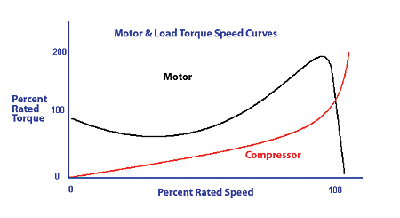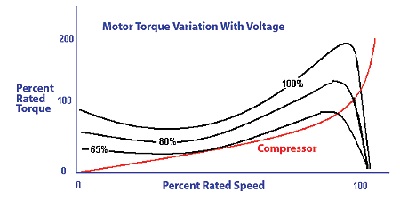
A frequent misconception is that a solid-state starter is the solution to every motor starting problem. After all, since it can ramp the motor voltage gradually from zero to 100% at a user-selected rate, can't it limit the inrush current to any desired value and smoothly bring the motor up to speed just by selecting a long enough acceleration time? The answer is no, because this thinking overlooks two important factors in the motor starting process: torque and heat.
A System Approach
Accelerating the system, consisting of the motor and the driven equipment, from rest to operating speed requires torque. How much depends upon the rotational moment of inertia of the system, J, and the torque-speed characteristic of the load. Some equipment, such as compressors or pumps with controlled discharge valves, may start in an unloaded condition, leaving only the inertia to be considered. Other equipment, such as pumps with standard check valves or conveyors, may require torque during acceleration.Figure 1 represents a typical motor torque-speed curve at full voltage superimposed on the torque-speed curve of a centrifugal compressor. The motor torque is higher than the load torque all the way from rest to the normal operating speed of the system, which is the point where the two curves cross. The difference between motor and load torque results in the acceleration of the system according to the equation TM - TL = Ja. If this margin drops to zero at any point prior to reaching the desired operating speed, the system will stop accelerating and remain at that speed.
Under full-voltage conditions, a typical motor draws 6 to 8 times full load current until it reaches approximately 90% of rated speed, at which point the current begins to drop off to full load current at rated rpm. Solid-state starters reduce starting current by proportionally reducing voltage. Motor torque is proportional to the square of voltage, so torque drops off faster than current as voltage is reduced. The degree to which inrush current can be reduced is thus dependent on how much torque margin exists to begin with. Figure 2 shows a family of motor torque-speed curves at various voltages. In this example, a voltage below 65% will result in failure to reach operating speed as the system will stop accelerating when the 65% motor torque curve crosses the load torque curve.
In this case, despite the range of voltage control available from the starter, the inrush current cannot be held lower than 65% of the full voltage value and still successfully start the motor. In fact, a somewhat higher voltage (and inrush current) is required, because even if reduced voltage doesn't result in the curves actually crossing, reducing the torque margin will significantly increase the acceleration time. Even at reduced currents, internal heat generated during lengthy acceleration periods may cause winding and rotor temperatures to exceed their ratings and result in overload relay tripping and/or thermal damage.




